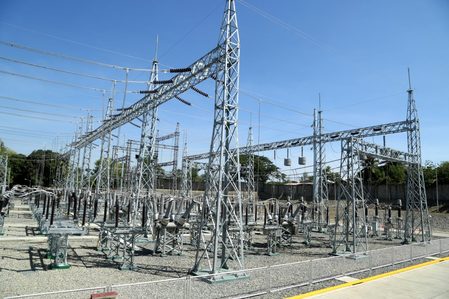
Upgrade to High-Speed Internet for only ₱1499/month!
Enjoy up to 100 Mbps fiber broadband, perfect for browsing, streaming, and gaming.
Visit Suniway.ph to learn
The Maharlika Investment Corporation (MIC) has courted controversy since its inception in July 2023 as a pivotal institution under Republic Act 11954, tasked with the stewardship of the country’s first sovereign wealth fund, the Maharlika Investment Fund (MIF).
This stigma continues to haunt MIC in its first act to invest some funds of the MIF in Synergy Grid & Development Philippines Incorporated (SGP), as proxy to preliminarily get a stake into the enviable money-making business monopoly of the National Grid Corporation of the Philippines (NGCP) in managing the country’s state-owned power grid.
While questions about the soundness of the financial returns from the investment looks well, in all appearances, considering the enormous dividends SGP shareholders have been receiving — which is expected to continue into the future — as NGCP holds the monopoly to operate the national power industry backbone, does this also mean that MIC’s investment move in SGP is a strong signal for small investors to follow?
Likewise, SGP looks like a good candidate to grow one’s investments through the old but reliable investment scheme called the “dividend reinvestment plan” (DRIP) or as a simple investment game plan to live on dividend income (LODI) because of the big fortune SGP is amassing out of its corporate umbilical connection with NGCP’s lucrative monopoly business.
The DRIP is an investment program that allows shareholders to automatically reinvest their cash dividends received from that company to purchase additional shares of the same stock, allowing them to compound their returns over time by buying more shares with each dividend payout. LODI, on the other hand, is just like the common investment practice to live on interest (LOI) income but with the opportunity to reap additional capital gains when the price of the shares held goes up.
Again, could this investment move by MIC be also a good lead for small investors to follow? Let’s take a look.
SGP’s status
SGP was originally the listed mining firm Mankayan Minerals Development Company incorporated on June 1, 1970. It assumed another name as UEM Development Philippines lncorporated on February 22, 1994 after the approval of its application for change of corporate name and change in primary purpose from that of “engaging in mining activities to general construction and other allied businesses.”
On March 28, 2011, it again molted into another name. This time into its present name after the Securities and Exchange Commission (SEC) once again approved its application for change of name along with the change of its primary purpose “to engage in power, energy, utilities, infrastructure and allied businesses.”
On December 20, 2019, SGP entered into a share-swap transaction with OneTaipan Holdings Incorporated (OTHI), a company controlled by Henry Sy Jr., and Pacifica2 Holdings Incorporated (P21), a company controlled by Roberto Coyuito Jr., resulting in SGP owning and controlling 67% interest in the outstanding shares of both firms.
The share-swap transaction was undertaken to formally consolidate the ownership and control of both firms in NGCP because “OTHI has a controlling interest in Monte Oro Grid Resources Corporation (MOGRC), which holds 30% plus one share in National Grid Corporation of the Philippines (NGCP), while P21 owns controlling shares in Calaca High Power Corporation (CHPC), which in turn owns 30% minus one share in NGCP.”
As a result of the share swaps, SGP gained effective ownership in NGCP to 40.20%, and 60% control on the voting rights in NGCP through MOGRC and CHPC.
Meanwhile, the State Grid Corporation of China (SGCC) holds a 40% stake in NGCP, at the same time, a technical partner for the exclusive use of Chinese technology in the grid’s operation.
NGCP’s operating performance
In 2007, NGCP was granted by Congress a 25-year franchise to operate the Philippines’ power transmission network through a public bidding process. The agreement came with the possibility of renewal for another 25-year extension.
However, it was only on January 15, 2009 that NGCP had full control over the management and operation of the country’s nationwide transmission system.
Essentially, the terms of the franchise agreement were as follows: the National Transmission Corporation or TRANSCO, which is the government agency created under Republic Act 9136, namely the Electric Power Industry Reform Act (EPIRA) of 2001, will retain ownership of the transmission assets of the national grid’s power backbone.
In addition to be under the control of other related government agencies and units, the Energy Regulatory Commission (ERC) will oversee NGCP’s capital outlays, operating costs and regulate its revenues through a designed formula called the performance-based regulation (PBR) system that involves the calculation of a weighted average cost of capital (WACC).
NGCP’s service franchise, in contrast, carries the duties “to provide a reliable, efficient, and sustainable power transmission system that will support the energy needs of the country and contribute to its overall development.” In return, NGCP will be entitled to the revenues generated minus a 3% franchise tax, which should not be passed on to consumers.
This seemingly simple terms of agreement between NGCP and the government became fraught with serious claims of violations repudiated by each party.
NGCP is accused of a number of issues ranging from delays in the implementation of projects, faults in complying with a combination of regulatory hurdles, logistical challenges, and concerns about the company’s operational practices.
The Energy Regulatory Commission (ERC) has slapped NGCP with fines for failing to justify the delay in 34 of its 37 uncompleted transmission infrastructure projects.
Likewise, NGCP has been reproached by ERC for its use of the “as spent” approach in calculating maximum annual revenue (MAR). In particular, this refers to the interpretation by NGCP to recover its operating and capital (OPEX and CAPEX) expenditure based on the actual amounts spent, regardless of whether the projects are fully commissioned or operational. This is cited as contributory to rising transmission rates and potential inefficiencies.
Last but not the least, NGCP is accused of prioritizing the declaration of huge shareholder dividends, reportedly equivalent to a 91.2% payout ratio. A dividend payout ratio is a financial metric indicator on how much of the company’s profits are being returned to shareholders versus how much is being reinvested back into the business.
From its end, NGCP claimed that the delays are not exactly its fault, like the right-of-way problems they are facing. NGCP cited hard and lengthy regulatory hurdles and external factors as contributors to the delays. NGCP even accused ERC to be the real culprit in project delays because the latter has been delaying the approval of its capital expenditure projects.
This practice is claimed to have potentially hindered NGCP’s ability to adequately fund necessary capital expenditures for grid modernization and expansion, which has actually contributed to delays in completing crucial transmission projects that ultimately resulted in widespread brownouts and blackouts experienced in crucial areas of the archipelago in early 2024.
While NGCP has paid most of the fines imposed, it explored legal remedies to claims of payment for other alleged violations.
On February 24, SGP requested for a trading halt of its shares. This was in view of its disclosure of material information contained in its SEC Form-17-C dated February 24, 2025, relating to the final award (dated February 19, 2025) rendered by the Arbitral Tribunal of the Singapore International Arbitration Centre (SIAC) favoring NGCP against the Power Sector Assets & Liabilities Management Corporation (PSALM) and National Transmission Corporation (TRANSCO).
Recommendation
Since MIC has been under pressure to already produce income, the investment in SGP is actually good. MIC is given the unique chance to immediately realize respectable earnings and give government a foothold in NGCP.
As explained by MIC president and CEO, Rafael Jose D. Consing Jr. at the Monday Circle Forum on February 24, the preferred shares issued by SGP are convertible, conferred with voting rights, and are to receive dividend earnings equivalent to 6.5% per annum.
In the case of small investors, the investment in SGP is far from being ideal, much less recommended. We now have many listed companies with better business lines and excellent operating performances, at the same time, comparative dividend records.
SGP’s business has no economic value. It subsists on the business model similar to a tollway manning monopoly. Once the monopoly to man the tollway — like NGCP’s exclusive franchise to operate TRANSCO’s transmission assets — is taken away, it has zero value.
Hard to imagine, this scenario is real and is actually nearer from happening considering the rising clamor for the government to again regain control of the country’s power grid operation, together with the serious issues on the use of Chinese technology in NGCP’s operations and the potential national security risks associated with it.
Finally, SGP’s shareholders’ base is shallow. Shareholdings are concentrated in a few investors who can literally manipulate the market of SGP shares. Small investors won’t stand a chance in getting a good price. They will most likely end up holding the bag again while the few big investors will be laughing all the way to the bank to deposit their profits, so to speak. – Rappler.com
(The article has been prepared for general circulation for the reading public and must not be construed as an offer, or solicitation of an offer to buy or sell any securities or financial instruments whether referred to herein or otherwise. Moreover, the public should be aware that the writer or any investing parties mentioned in the column may have a conflict of interest that could affect the objectivity of their reported or mentioned investment activity. You may reach the writer at densomera@yahoo.com)

 1 month ago
10
1 month ago
10



![[Vantage Point] NGCP – what’s wrong with it?](https://www.rappler.com/tachyon/2024/01/whats-wrong-with-ngcp-january-30-2024.jpg?fit=449%2C449)






